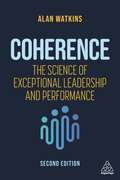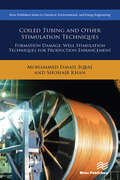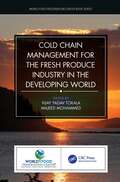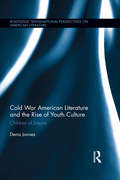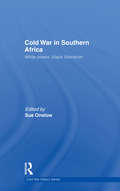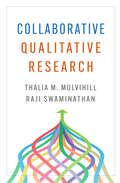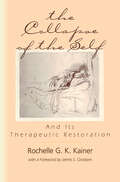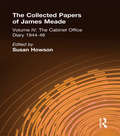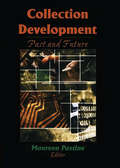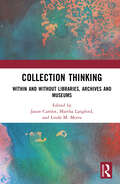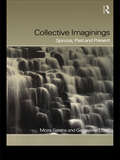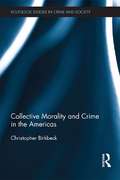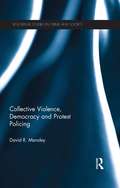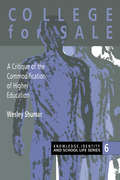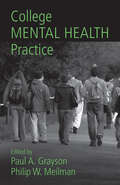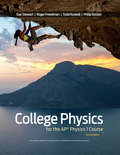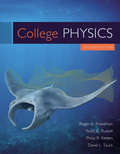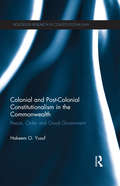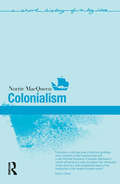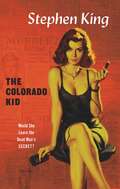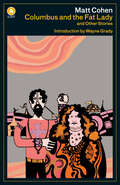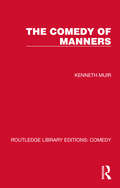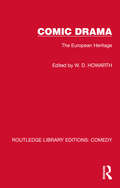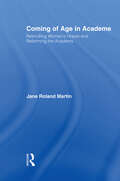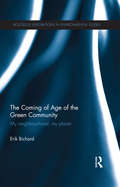Special Collections
Benetech’s Global Certified Accessible Titles
Description: Benetech’s GCA program is the first independent third-party EPUB certification to verify ebook accessibility. By creating content that is born accessible, publishers can meet the needs of all readers. Learn more: https://bornaccessible.benetech.org/
- Table View
- List View
Coherence
by Dr Alan WatkinsUnderstand how to overcome the obstacles inhibiting performance and unlock the potential for brilliance that lies within every leader.Most leaders are operating nowhere near their optimal level of performance. In this book, Dr Alan Watkins helps leaders at every level understand how they can transform their output and unlock their true potential. He shares proven techniques that have helped thousands of leaders in FTSE 50 giants and SMEs across market sectors and geographies as well as the Olympic and Paralympic Rowing Team, resulting in them achieving their best ever medal haul in London 2012.Coherence shows how our ability to lead and deliver results is rooted in our biology. Dr Watkins explains the science of how to increase energy levels and become smarter, more resilient, happier, healthier and more successful in whatever we do. Drawing on case studies from prominent business leaders and insights from a diverse range of research fields, he reveals the secrets to exceptional leadership and how to be brilliant every day. Now in its second edition, this vital guide contains upgraded practical tools and new insights on how to transform productivity, manage complexity, accelerate innovation and drive greater commercial performance, all while becoming healthier and happier.
Coiled Tubing and Other Stimulation Techniques
by Mohammed Ismail IqbalGood engineers never stop looking for opportunities to improve the performance of their production systems. Performance enhancement methods are always carefully examined, and production data is analyzed in order to identify determining factors affecting performance.The two main activities of the production engineer in the petroleum and related industries are reservoir stimulation and artificial lift. The classic solution to maximizing a well's productivity is to stimulate it. The basis for selecting stimulation candidates should be a review of the well's actual and theoretical IPR. Low permeability wells often need fracturing on initial completion. In low permeability zones, additional post stimulation production can be significant to the economics, however, the production engineer needs to make management aware of the true long term potential or else overly optimistic projections can easily be made.The main purpose of stimulation is to enhance the property value by the faster delivery of the petroleum fluid and/or to increase ultimate economic recovery. The aim of reservoir stimulation is to bypass near-wellbore damage and return a well to its “natural” productivity / injectivity, to extend a conductive path deep into a formation and thus increase productivity beyond the natural level and to produce hydrocarbon from tight formation.The importance of reservoir stimulation is increasing due to following reasons: • Hydrocarbon fields in their mid-life• Production in these fields are in declining trend• The thrust area: Enhancement of productionHence, to improve productivity of the well matrix stimulation and hydraulic fracturing are intended to remedy, or even improve, the natural connection of the wellbore with the reservoir, which could delay the need for artificial lift.This book presents procedures taken in the Oil & Gas Industry for identifying well problems, and it suggests means of solving problems with the help of the Coil Tube unit which is used for improving well productivity and techniques like Acidizing and Hydraulic Fracturing.
Cold Chain Management for the Fresh Produce Industry in the Developing World
by Vijay Yadav TokalaGlobal food losses are a result of a lack of necessary infrastructure, improper food safety handling procedures, and insufficient training for the personnel working in the cold chain. The development of a resource-efficient and energy-smart food supply chain requires a well-integrated evaluation and development of the cold chain. Cold Chain Management for the Fresh Produce Industry in the Developing World provides a comprehensive review of the benefits of an unbroken cold chain in developing countries and focuses on the critical role of extension education in the implementation of cold chain management. The unbroken cold chain is essential for all stakeholders in the fresh produce industry to maintain the quality and safety of food products during handling, transporting, and storing in their journey from producer to consumer. Appropriate cold chain management is crucial not only to reduce the postharvest losses and wastages, but also to increase farmers' income, generate employment opportunities, and improve the livelihood of stakeholders along the supply chain. Key Features: Includes case studies for promoting the expansion of existing technologies for cold chain development in Asian, Africa and the Caribbean nations. Assesses cold chain management as crucial to the growth of global trade in perishable products with contributions from international organizations, researchers and commercial experts. Articulates resilient, sustainable and creative concepts to develop cold chains to enhance food distribution. This book comprises of chapters contributed by the experts and practitioners of cold chain development in developing countries. The authors in the book provide the scenario of cold chain management in the world and discuss the importance of the cold chain as well as the different options and innovations of cooling systems. Chapters also include case studies, success stories, capacity building activities, and other opportunities in cold chain development.
Cold War American Literature and the Rise of Youth Culture
by Denis JonnesDemands placed on many young Americans as a result of the Cold War give rise to an increasingly age-segregated society. This separation allowed adolescents and young adults to begin to formulate an identity distinct from previous generations, and was a significant factor in their widespread rejection of contemporary American society. This study traces the emergence of a distinctive post-war family dynamic between parent and adolescent or already adult child. In-depth readings of individual writers such as, Arthur Miller, William Styron, J. D. Salinger, Tennessee Williams, Vladimir Nabokov, Jack Kerouac, Flannery O’Connor and Sylvia Plath, situate their work in relation to the Cold War and suggest how the figuring of adolescents and young people reflected and contributed to an empowerment of American youth. This book is a superb research tool for any student or academic with an interest in youth culture, cultural studies, American studies, cold war studies, twentieth-century American literature, history of the family, and age studies.
Cold War in Southern Africa
by Sue OnslowThis edited volume examines the complexities of the Cold War in Southern Africa and uses a range of archives to develop a more detailed understanding of the impact of the Cold War environment upon the processes of political change. In the aftermath of European decolonization, the struggle between white minority governments and black liberation movements encouraged both sides to appeal for external support from the two superpower blocs. Cold War in Southern Africa highlights the importance of the global ideological environment on the perceptions and consequent behaviour of the white minority regimes, the Black Nationalist movements, and the newly independent African nationalist governments. Together, they underline the variety of archival sources on the history of Southern Africa in the Cold War and its growing importance in Cold War Studies. This volume brings together a series of essays by leading scholars based on a wide range of sources in the United States, Russia, Cuba, Britain, Zambia and South Africa. By focussing on a range of independent actors, these essays highlight the complexity of the conflict in Southern Africa: a battle of power blocs, of systems and ideas, which intersected with notions and practices of race and class This book will appeal to students of cold war studies, US foreign policy, African politics and International History. Sue Onslow has taught at the London School of Economics since 1994. She is currently a Cold War Studies Fellow in the Cold War Studies Centre/IDEAS
Collaborative Qualitative Research
by Raji Swaminathan and Thalia M. MulvihillMeeting a key need for qualitative researchers, this practical book presents tools for creating productive partnerships and managing each phase of a collaborative project. The authors provide guidelines for working across disciplines, status differentials (such as professor and student), and geographical locations. Collaboration within particular qualitative traditions--cross-cultural research, duoethnography, participatory action research, arts-based collaborations, and others--is described and illustrated with exemplars of published studies. Readers learn how to build research teams, formulate research questions, gather and analyze data, and assess how collaborations are working. Ethical questions are highlighted throughout: Who owns collaborative research? Who decides what aspects of the findings should be disseminated? How can inequitable power relations be redressed? Within-chapter "Pedagogical Pathways" sections provide practice exercises and opportunities for reflection.
The Collapse of the Self and Its Therapeutic Restoration
by Rochelle G. KainerThe Collapse of the Self and Its Therapeutic Restoration is a rich and clinically detailed account of the therapeutic restoration of the self, and speaks to the healing process for analysts themselves that follows from Rochelle Kainer's sensitive integration of heretofore dissociated realms of psychoanalytic theory. In describing how the reworking of pathological internal object relationships occurs in conjunction with the transformation of selfobject failures, Kainer brings new insight to bear on the healing of the self at the same time as she contributes to healing the historic split in psychoanalysis between Kleinian theory and self psychology. Extensive case illustrations, refracted through the lens of her uniquely integrative perspective, bring refreshing clarity to elusive theoretical concepts. Of special note is Kainer's distinction between normal and pathological identifications. Equally valuable is her introduction of the term "imaginative empathy" to characterize the kind of attunement that is integral to analytic healing; her nuanced description of the relation between imaginative empathy and projective identification bridges the worlds of Kleinian theory and self psychology in an original and compelling way. She ends by spelling out how her theoretical viewpoint leads to a more comprehensive understanding of various clinical phenomena. The Collapse of the Self and Its Therapeutic Restoration, is a sophisticated yet accessible work, gracefully written, that elaborates a relational theory of thinking, of creativity, of identification, and of the formation and healing of psychic structure. Kainer's ability to bring the often dissonant voices of different psychoanalytic schools into theoretical harmony as she develops her viewpoint conveys both the breadth of intellectual engagement with colleagues and the depth of clinical engagement with patients that inform her project from beginning to end.
Collected Papers James Meade V4
by Susan HowsonFirst Published in 2004. Routledge is an imprint of Taylor & Francis, an informa company.
Collection Development
by Maureen PastineWith the prolific changes in the electronic environment, do you sometimes feel overwhelmed by the multiplying of electronic information resources, the different methods of access, and their combined impact on collection development? If so, Collection Development is the book to help you get a handle on what&’s out there! In no time at all, you&’ll be able to select and integrate electronic resources into collection development programs at even the most traditional of libraries! In the process, you will learn alternative approaches for dealing with electronic databases, on-line access, and fiscal planning for the integration of the new information technologies into collection development.Collection Development offers useful strategies for dealing with electronic resources in terms of selection and evaluation, collection development policies, organizational structure, and budgeting. You also acquire important information on: Internet information resources accessible through Gophers and World Wide Web sites access vs. ownership issues serving the remote user at an extended campus site the relationship of selection to acquisitions managing a CD-Rom collection development process planning issues of cooperation, collaboration, and change pricing and planning issues and their impact on library budgets negotiating site licensesLibrarians in collection development, academic librarians, and personnel in technology/authomation development will find Collection Development an indispensable tool for grappling with the demands and pressures of screening and choosing the most suitable information resources from the dynamic, even saturated, world of technology. The book&’s insights and practical methodologies will help you integrate new on-line and electronic information resources into your program with relative ease.
Collection Thinking
by Linda M. Morra and Jason Camlot and Martha LangfordCollection Thinking is a volume of essays that thinks across and beyond critical frameworks from library, archival, and museum studies to understand the meaning of "collection" as an entity and as an act. It offers new models for understanding how collections have been imagined and defined, assembled, created, and used as cultural phenomena. Featuring over 70 illustrations and 21 original chapters that explore cases from a wide range of fields, including library and archival studies, literary studies, art history, media studies, sound studies, folklore studies, game studies, and education, Collection Thinking builds on the important scholarly works produced on the topic of the archive over the past two decades and contributes to ongoing debates on the historical status of memory institutions. The volume illustrates how the concept of "collection" bridges these institutional and structural categories, and generates discussions of cultural activities involving artifactual arrangement, preservation, curation, and circulation in both the private and the public spheres. Edited and introduced collaboratively by three senior scholars with expertise in the fields of literature, art history, archives, and museums, Collection Thinking is designed to stimulate interdisciplinary reflection and conversation. This book will be of interest to scholars and practitioners interested in how we organize materials for research across disciplines of the humanities and social sciences. With case studies that range from collecting Barbie dolls to medieval embroideries, and with contributions from practitioners on record collecting, the creation of sub-culture archives, and collection as artistic practice, this volume will appeal to anyone who has ever wondered about why and how collections are made.
Collective Imaginings
by Moira Gatens and Genevieve LloydWhy would the work of the 17th century philosopher Benedict de Spinoza concern us today? How can Spinoza shed any light on contemporary thought?In this intriguing book, Moira Gatens and Genevieve Lloyd show us that in spite of or rather because of Spinoza's apparent strangeness, his philosophy can be a rich resource for cultural self-understanding in the present.Collective Imaginings draws on recent re-assessments of the philosophy of Spinoza to develop new ways of conceptualising issues of freedom and difference. This ground-breaking study will be invaluable reading to anyone wishing to gain a fresh perspective on Spinoza's thought.
Collective Morality and Crime in the Americas
by Christopher BirkbeckThis study examines the ways in which the moral community is "talked into being" in relation to crime, and the objects of concern that typically occupy its attention. It maps the imagined moral universe of the virtuous and the criminal and charts the relations between these two groups in the "history of the present." It examines the calls to action which symbolically endow the moral community with power. And it looks at the character and content of collective moralizing. The source materials are commentaries about crime and criminal justice appearing in selected newspapers across the Americas. The moral "talk" found there is stylized, routine, trivial and occasionally dramatic. It looks nothing like the weightier renderings of morality that derive from the reconstruction of a particular "ethic" or from the systematic probing of values and moral reasoning. And its fuzzy, offhand, unexceptional and frequently unsystematic nature makes it a difficult candidate for explaining either stability or change in crime policies. But moral talk has intrinsic importance as the creator and sustainer of an imagined moral community, a community that symbolizes the existence and vigor of morality itself and confers a crucially important identity on its self-proclaimed members. And moral talk reveals inherent intersections between normative, empirical and technical discourses, highlighting the relationships between morality, science and social engineering. Thus, a prosaic, instrumental, model of morality is particularly strong in North America, but only found in a more abstract form in Latin America, where it sits alongside a stirring vision of morality, more directly anchored in virtue. Research on social problems, moral panics and the sociology of morality has largely overlooked the type of moral discourse studied here. While emphasizing the culturally contingent nature of the findings, the conclusion reflects on their significance for understanding the nature of moralizing, the artifacts of talk and the construction of identity.
Collective Violence, Democracy and Protest Policing
by David R MansleyIn this book David Mansley argues that the frequency with which violence intrudes on to the streets is related to both how society is governed and how it is policed. With the help of an innovative methodology, he quantifies and tests three variables – collective violence, democracy and protest policing – using protests in Great Britain in 1999–2011, for his sampling frame. The result is the design of new tools of measurement and a harvest of new data, including previously unpublished details of banning orders and riot damages, that enable us to reflect, with the benefit of broad sociological perspective, on the causes of contemporary violent events. Mansley’s explanation of the trends he identifies draws from the work of the best thinkers on violence – especially Charles Tilly, Thomas Hobbes and Norbert Elias. He shows how the style of protest policing and the depth of democracy, both of which function under the direction of the political economy, are crucial to the state’s credentials as the monopoly supplier of legitimate violence. His discussion touches on such current topics as the institution of police commissioners, the privatisation of policing duties, and the decline in homicide. This cultured study, which includes an engaging review of the existing scholarship on violence, is essential material for undergraduate and postgraduate students reading criminology, sociology or political theory.
College For Sale
by Wesley ShumarThis text provides a framework for understanding higher education in the US and other western countries since the 1970s whereby the logic of the market place has increasingly come to dominate all arenas and, in context, the education system. The author calls this process "commodification" and he describes the transformation of universities in the US and elsewhere as they attempt to accomodate the enforced changes on their academic lives and those of their students.; The book chronicles changes with the increasing focus on career and the movement towards the instrumental functions of education; the financial crisis and the development of a more corporate approach to education; of consumption that produce universities heavy with expensive, well-equipped and powerful administrations and decreasing numbers of ever more disenfranchised faculty.
College Mental Health Practice
by Paul A. Grayson and Philip W. MeilmanPaul Grayson, a co-editor of the successful 1989 book College Psychotherapy, has teamed up with Phil Meilman, a seasoned veteran of college counseling and psychological services, to compile this needed comprehensive up-to-date treatment guide. After an opening discussion of the campus environment and student mentality, the book provides an overview of the state of college mental health at the start of the 21st century, touching on the issues faced by students of every generation, as well as those concerns unique to this day and age. With an emphasis on practice, and not theory, this easily referenced treatment guide will be of use to anyone working in the mental health fields in and around a college environment.
College Physics for the AP Physics 1 Course
by Roger Freedman and Gay Stewart and Todd Ruskell and Philip KestenCollege Physics for the AP® Physics 1 Course is the first textbook to integrate AP® skill-building and exam prep into a comprehensive college-level textbook, providing students and teachers with the resources they need to be successful in AP® Physics 1. Throughout the textbook you’ll find AP Exam Tips, AP® practice problems, and complete AP® Practice Exams, with each section of the textbook offering a unique skill-building approach. Strong media offerings include online homework with built-in tutorials to provide just-in-time feedback. College Physics provides students with the support they need to be successful on the AP® exam and in the college classroom.
College Physics (Second Edition)
by Roger A. Freedman and Todd G. Ruskell and Philip R. Kesten and David L. TauckFreedman College Physics, Second Edition, is a student-centered text and homework program for introductory, algebra-based physics courses. With a focus on conceptual understanding and biological applications, College Physics makes the relevance of physics clear to students. The Sapling Plus system combines the heavily researched FlipIt Physics prelectures (derived from smartPhysics) with a robust homework system, in which every problem has targeted feedback, a hint, and a fully worked and explained solution.
Colonial and Post-colonial Constitutionalism in the Commonwealth
by Hakeem O. YusufThe peace, order and good government (POGG) clause is found in the constitutions of almost all Commonwealth countries. Since its introduction, the clause has played a significant role in colonial and post-colonial constitutionalism in Commonwealth jurisdictions.This book is the first full length analysis of the various dimensions of the peace, order and good government clause. It argues that the origins of the POGG clause mark it out as an anachronistic feature of British constitutionalism when seen against a modern setting of human rights, liberty and democratisation. The book traces the history, politics and applications of the clause through the colonial period in Commonwealth territories to date. It provides critical evaluation of the POGG clause in a cross-continental enquiry, examining statutory, political and constitutional deployment in Australia, Canada, India, Nigeria, South Africa and the United Kingdom. The evaluation demonstrates that the POGG clause has relevance in a number of significant aspects of legal and socio-political ordering across the Commonwealth featuring prominently in the federalism question, emergency powers and the review of administrative powers. It maintains that while the clause is not entirely devoid of positive value, the POGG clause has been used not only to further the objects of colonialism, but also authoritarianism and apartheid. This book calls for a rethink of the prevailing subjective approach to the interpretation of the clause. The book will be of interest to students and academics of public law, human rights law, and comparative politics.
Colonialism
by Norrie MacqueenEurope’s rapacious hunger for other people’s lands is one of the key shaping forces of our contemporary world. Everything is touched by our colonial past, from the way we see the world to the food we eat. Our contemporary preoccupations and ills – from globalization to humanitarian intervention to international terrorism – have colonialism somewhere in their genetic make-up. The character and policies of contemporary international organizations – from the United Nations to the European Union - have also been deeply affected by the colonial inheritance of their members, whether as perpetrators or “victims”. Weaving together the complex strands of history and politics into one compact narrative, this book addresses the key theories of colonialism, examining them against contemporary realities. It goes on to looks at how the different policies of colonisers have had profoundly contradictory effects on the way different empires ended in the 20th century. These endings in turn affected the entire nature of modern day international relations. It also exposes the moral ambiguities of colonialism and the hypocrisies, which underlay colonial policies in the 19th and 20th centuries.
The Colorado Kid
by Stephen KingOn an island off the coast of Maine, a man is found dead. There's no identification on the body. Only the dogged work of a pair of local newspapermen and a graduate student in forensics turns up any clues. But that's just the beginning of the mystery. Because the more they learn about the man and the baffling circumstances of his death, the less they understand. Was it an impossible crime? Or something stranger still...? No one but Stephen King could tell this story about the darkness at the heart of the unknown and our compulsion to investigate the unexplained. With echoes of Dashiell Hammett's The Maltese Falcon and the work of Graham Greene, one of the world's great storytellers presents a surprising tale that explores the nature of mystery itself...
Columbus and the Fat Lady
by Matt CohenFirst published in 1972, Columbus and the Fat Lady introduced readers to Governor General’s Literary Award–winning author Matt Cohen’s skewed and hilarious worldview. By turns funny, surreal, wistful, savagely satirical, and brilliantly inventive, the stories in this collection intrigue and surprise the reader with their unexpected language and plots. He conjures up images that are both absurd and perceptive. From Sir Galahad as a schoolteacher to Christopher Columbus as a carnival attraction, these stories feature the improbable with strength and virtuosity. This collection is a foray into the jungles of life on this planet and the tangled but fascinating interiors of the human head.
The Comedy of Manners
by Kenneth MuirOriginally published in 1970, this title starts with an introduction, in which Professor Muir distinguishes between the Comedy of Manners and other types of comedy and traces its origins in English and French literature, there are then chapters on the major writers – Etherege, Dryden, Wycherly, Congreve, Vanbrugh, Farquhar – and on Jeremy Collier’s attack on the immorality and profaneness of the plays. This is followed by a discussion of the reasons for the decline of comedy in the eighteenth century and an account of its revival by Sheridan and, belatedly, by Wilde. Professor Muir takes issue with a number of recent critics on the dramatic value of the plays.
Comic Drama
by W. D. HowarthEver since comedies were first performed in the ancient world, the definition of the term ‘comedy’ has been debated by both playwrights and critics. Originally published in 1978, this volume does not attempt a precise definition, but reviews the various interpretations that have been put forward through the ages, taking as evidence important theoretical writings as well as the plays themselves, and pointing out not only common features but also notable exceptions. The comic drama of Western Europe since the Renaissance is here surveyed in a series of chapters devoted principally to the tradition of European comedy as it developed in the major national literatures. The perspective is expanded to include, on the one hand, the origins in classical Greece and Rome and, on the other, the influence of cinema, radio and television comedy at the time – American as well as European. A structural basis for the volume as a whole is provided in an analytical introduction, where the essential problems are defined: such issues as the relationship between comedy and satire, comedy and farce; the distinction between laughter and smile; the respective claims of realism and fantasy; the role of plot and of dialogue; the place of sentiment and of moral teaching; and the possibility of comic catharsis. In this way the nature and evolution of European comedy is presented in an original and coherent form, not only offering an invaluable aid to students seeking guidance in literature of which they are not making a specialist study, but stimulating the more experienced reader to think again about familiar plays.
Coming of Age in Academe
by Jane Roland MartinFirst Published in 2000. Routledge is an imprint of Taylor & Francis, an informa company.
The Coming of Age of the Green Community
by Erik BichardPeople organising to protect their environment is not a new phenomenon, but the groups that have been pushing for environmental change since the 1970s have not convinced sufficient numbers make sustainable decisions or to lead sustainable lives. Governments have serially failed to do the job at the international level. Now, climate change, resource depletion and widening social aspirations threaten to destabilise human society unless sustainable change can be influenced from another direction. The Coming of Age of the Green Community explores the activities of a new generation of community-led initiatives that may herald the beginnings of the next wave of activism. Erik Bichard combines the testimonies of dozens of group activists with historic evidence and the views of a range of commentators from a variety of disciplines to put forward reasons why some green community groups succeed while others fail. He concludes with a valuable prescription for both existing and emerging groups on how to be sustainable, both over time and in their actions. This book address one of the key questions of the twenty-first century: has the local perspective on this universal concern finally come of age?
